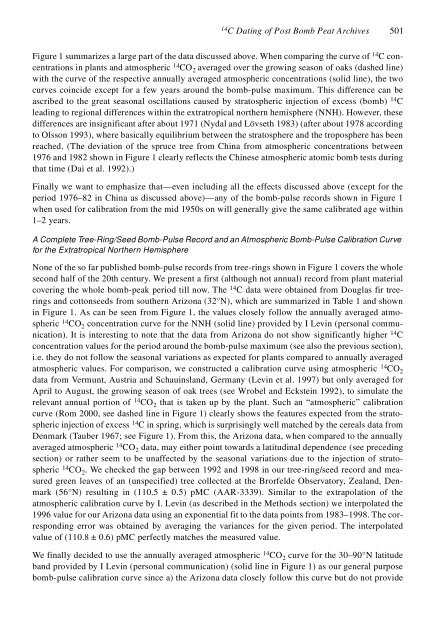FATE OF MERCURY IN THE ARCTIC Michael Evan ... - COGCI
FATE OF MERCURY IN THE ARCTIC Michael Evan ... - COGCI
FATE OF MERCURY IN THE ARCTIC Michael Evan ... - COGCI
Create successful ePaper yourself
Turn your PDF publications into a flip-book with our unique Google optimized e-Paper software.
14 C Dating of Post Bomb Peat Archives 501<br />
Figure 1 summarizes a large part of the data discussed above. When comparing the curve of 14 C concentrations<br />
in plants and atmospheric 14 CO 2 averaged over the growing season of oaks (dashed line)<br />
with the curve of the respective annually averaged atmospheric concentrations (solid line), the two<br />
curves coincide except for a few years around the bomb-pulse maximum. This difference can be<br />
ascribed to the great seasonal oscillations caused by stratospheric injection of excess (bomb) 14 C<br />
leading to regional differences within the extratropical northern hemisphere (NNH). However, these<br />
differences are insignificant after about 1971 (Nydal and Lövseth 1983) (after about 1978 according<br />
to Olsson 1993), where basically equilibrium between the stratosphere and the troposphere has been<br />
reached. (The deviation of the spruce tree from China from atmospheric concentrations between<br />
1976 and 1982 shown in Figure 1 clearly reflects the Chinese atmospheric atomic bomb tests during<br />
that time (Dai et al. 1992).)<br />
Finally we want to emphasize that—even including all the effects discussed above (except for the<br />
period 1976–82 in China as discussed above)—any of the bomb-pulse records shown in Figure 1<br />
when used for calibration from the mid 1950s on will generally give the same calibrated age within<br />
1–2 years.<br />
A Complete Tree-Ring/Seed Bomb-Pulse Record and an Atmospheric Bomb-Pulse Calibration Curve<br />
for the Extratropical Northern Hemisphere<br />
None of the so far published bomb-pulse records from tree-rings shown in Figure 1 covers the whole<br />
second half of the 20th century. We present a first (although not annual) record from plant material<br />
covering the whole bomb-peak period till now. The 14 C data were obtained from Douglas fir treerings<br />
and cottonseeds from southern Arizona (32°N), which are summarized in Table 1 and shown<br />
in Figure 1. As can be seen from Figure 1, the values closely follow the annually averaged atmospheric<br />
14 CO 2 concentration curve for the NNH (solid line) provided by I Levin (personal communication).<br />
It is interesting to note that the data from Arizona do not show significantly higher 14 C<br />
concentration values for the period around the bomb-pulse maximum (see also the previous section),<br />
i.e. they do not follow the seasonal variations as expected for plants compared to annually averaged<br />
atmospheric values. For comparison, we constructed a calibration curve using atmospheric 14 CO 2<br />
data from Vermunt, Austria and Schauinsland, Germany (Levin et al. 1997) but only averaged for<br />
April to August, the growing season of oak trees (see Wrobel and Eckstein 1992), to simulate the<br />
relevant annual portion of 14 CO 2 that is taken up by the plant. Such an “atmospheric” calibration<br />
curve (Rom 2000, see dashed line in Figure 1) clearly shows the features expected from the stratospheric<br />
injection of excess 14 C in spring, which is surprisingly well matched by the cereals data from<br />
Denmark (Tauber 1967; see Figure 1). From this, the Arizona data, when compared to the annually<br />
averaged atmospheric 14 CO 2 data, may either point towards a latitudinal dependence (see preceding<br />
section) or rather seem to be unaffected by the seasonal variations due to the injection of stratospheric<br />
14 CO 2. We checked the gap between 1992 and 1998 in our tree-ring/seed record and measured<br />
green leaves of an (unspecified) tree collected at the Brorfelde Observatory, Zealand, Denmark<br />
(56°N) resulting in (110.5 ± 0.5) pMC (AAR-3339). Similar to the extrapolation of the<br />
atmospheric calibration curve by I. Levin (as described in the Methods section) we interpolated the<br />
1996 value for our Arizona data using an exponential fit to the data points from 1983–1998. The corresponding<br />
error was obtained by averaging the variances for the given period. The interpolated<br />
value of (110.8 ± 0.6) pMC perfectly matches the measured value.<br />
We finally decided to use the annually averaged atmospheric 14 CO 2 curve for the 30–90°N latitude<br />
band provided by I Levin (personal communication) (solid line in Figure 1) as our general purpose<br />
bomb-pulse calibration curve since a) the Arizona data closely follow this curve but do not provide


